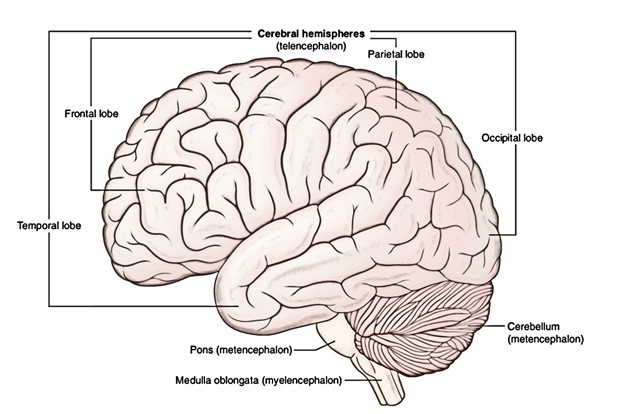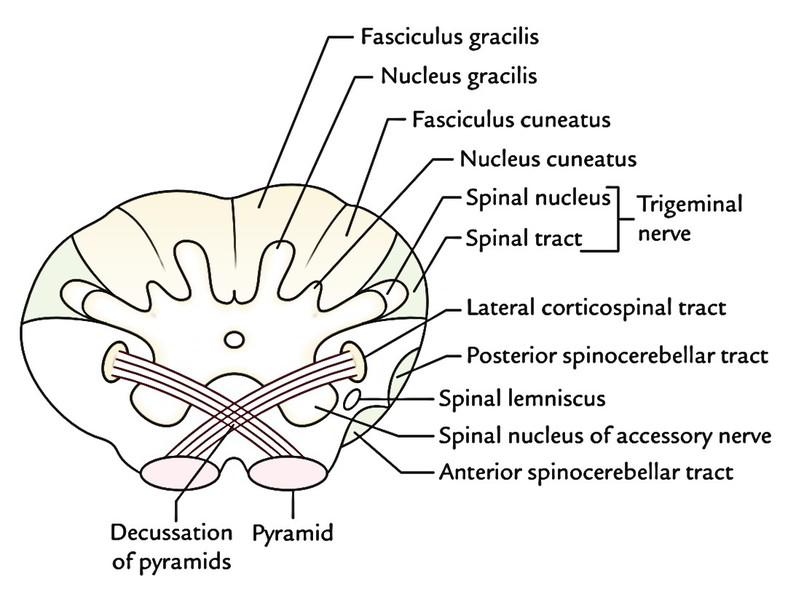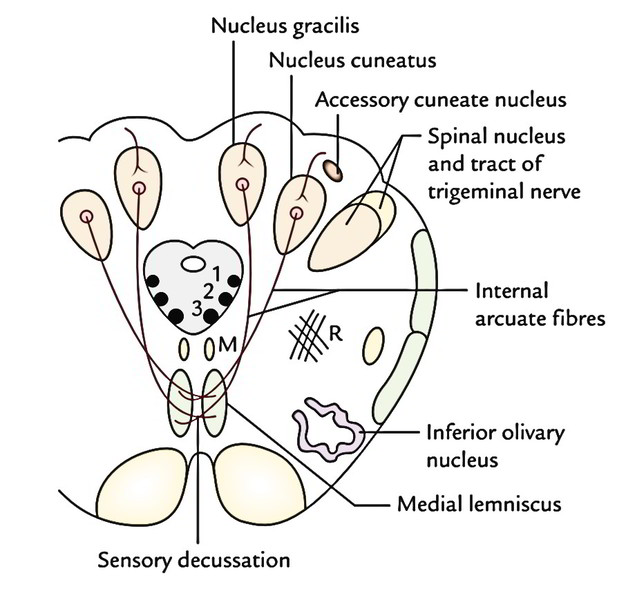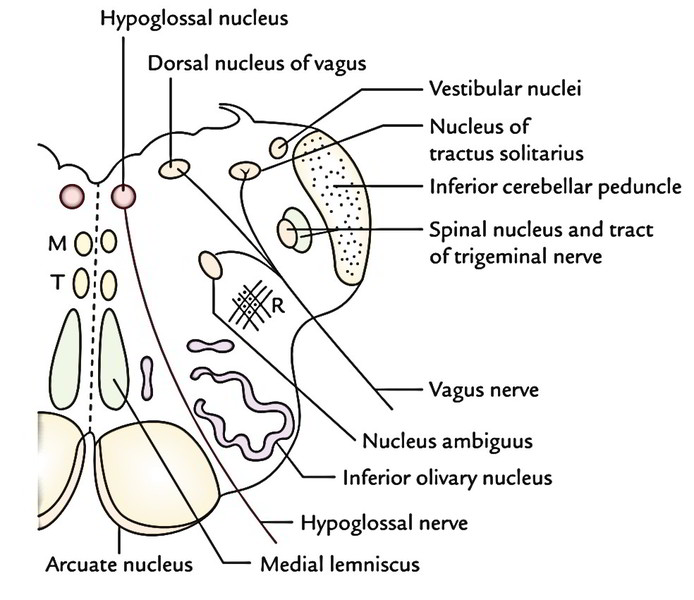
- The medulla oblongata is continuous inferiorly with the spinal cord in the foramen magnum and is the lower part of the brainstem.
- On the ventral aspect of medulla, there are 2 pyramid-shaped altitudes, 1 on either side of median plane termed pyramids. Sidelong to the pyramids, there are just two oval altitudes referred to as olives including inferior olivary nuclei. Dorsal to every olive is an inferior cerebellar peduncle. These altitudes are made by the descending fibres of the corticospinal tracts affected in the conscious charge of the skeletal muscles.
- Generated by likewise called nuclei below them on both sides, on the dorsal aspect, the medulla has cuneate and gracile tubercles.
- Medulla gives connection to the past 4 cranial nerves.
- The lower part of the medulla, such as the spinal cord, includes the central canal. In the upper part of the medulla, this canal widens and moves dorsally to create the lower part of the 4th ventricle. So, the medulla is split into 2 parts: a lower closed part of medulla and an upper open part.
- Medulla includes different essential autonomic centers responsible for many reflexes, like those involved in the regulation of heart rate, blood vessel diameter, breathing, swallowing, vomiting, coughing and sneezing.
External Features
- The medulla is split into left and right symmetrical halves by the anterior median fissure and posterior median sulcus.
- The anterior median fissure is continuous below with the corresponding fissure on the spinal cord and above it finishes into a small triangular depression named the foramen cecumat the lower border of the pons. It’s interrupted in its lower part by the bundles of fibres crossing obliquely from 1 side to the other, the decussation of pyramids.
- The posterior median sulcus continues below with the corresponding sulcus of the cord and is present only in the lower half of the medulla. Above, its lips diverge to create the borders of a triangular area, the lower part of the floor of the 4th ventricle.
- Every half of the medulla is marked by 2 sulci, anterolateral and posterolateral that are direct upward continuations of the corresponding sulci of the cord.
- The anterolateral sulcus travels along the lateral border of the pyramid and along it issue the rootlets of the hypoglossal (12th cranial) nerve.
- The posterolateral sulcus is located between the olive and the inferior cerebellar peduncle and along it come the rootlets of the glossopharyngeal (9th), vagus (10th) and cranial root of accessory (11th) cranial nerves.
Features on The Ventral Aspect
The ventral aspect of medulla presents the following features:
- Pyramids: All these are 2 elongated altitudes, 1 on either side of the anterior median fissure and are generated by the underlying corticospinal (pyramidal) fibres.
- Olives: All these are oval levels, posterolateral to the pyramids and are created by an underlying mass of grey matter named inferior olivary nucleus.
- Rootlets of the hypoglossal nerve: These come from the anterolateral sulcus between the pyramid and the olive.
- Inferior cerebellar peduncles: All these are thick bundles of fibres being located posterolateral to the olive and connect the medulla with the whole cerebellum.
- Rootlets of the 9th, 10th and 11th (cranial part) cranialnerves: These come via the posterolateral sulcus separating the olive from the inferior cerebellar peduncle.
Features on the Dorsal Aspect
The dorsal aspect of the medulla is well demarcated into lower closed and upper open parts.
Features of the Closed Part
The closed part, on each side of the posterior median sulcus, presents 3 longitudinal levels. From medial to lateral these are: fasciculus gracilis, fasciculus cuneatus and inferior cerebellar peduncle. The upper ends of the fasciculus gracilis and fasciculus cuneatus enlarge to create the gracile and cuneate tubercles, respectively, because of underlying nuclei of exactly the same name.
Another elevation current lateral to cuneate tubercle; the tuber cinereum is generated by the spinal nucleus of the trigeminal nerve.
Features of the Open Part
The open part of the medulla creates the lower part of the floor of the 4th ventricle which presents a number of features like, median sulcus, hypoglossal and vagal triangles, vestibular regions, area postrema, stria medullaris, etc.
Internal Structure
The internal structure of medulla is well valued by analyzing its transverse sections (T.S.) at the following 3 levels:
- At the level of decussation of pyramids.
- At the level of sensory decussation.
- At the level of the olives.
TS of Medulla at the Level of Decussation of Pyramids
The trade at this level strongly resembles that of the spinal cord and goes through the inferior half of the medulla. On the other hand, the following significant features are detected at this level:
- The nucleus gracilis and nucleus cuneatus appear as narrow strip-like projections from the posterior aspect of the central grey matter.
- The apex of posterior horn swells up to create the nucleus of the spinal tract of the trigeminal nerve.
- The spinal tract of the trigeminal nerve is a bundle of fibres, which tops the nucleus of the spinal tract of the trigeminal nerve.
Decussation of pyramidal tracts creates the most essential attribute of medulla at this level. About 75% fibres of pyramidal tract run backwards and laterally through the midline to get to the lateral white column of the other side of the spinal cord in the place where they run downward as the lateral corticospinal tract. In doing this, the anterior horns are detached from the central grey matter.
Every detached anterior horn breaks up to create the spinal nucleus of the accessory nerve and the supraspinal nucleus of the 1st cervical nerve.
Diffuse zone seems comprising a network of fibres and dotted nerve cells inside it, in the lateral white column adjacent to the nucleus of the spinal tract of the trigeminal nerve is known as reticular formation.
TS of Medulla at the Level of Sensory Decussation
This section goes through the middle of medulla and displays the following features:
- The nucleus gracilis and nucleus cuneatus become more noticeable and are divided from the central grey matter. The fibres of fasciculus gracilis and fasciculus cuneatus terminate in these nuclei.
- The internal arcuate fibres originating from gracile and cuneate nuclei course forwards and medially around the central grey matter and decussate with corresponding fibres of opposite side in the median plane (sensory decussation) and after that turn upward to ascend as the medial lemniscus on the opposite side near the median plane.
- The internal arcuate fibres cut off the spinal nucleus and tract of the trigeminal nerve from the central grey matter.
- Instantly dorsolateral to the cuneate nucleus is located the accessory cuneate nucleus which gets the more lateral fibres (originated from the cervical parts of the cord) of the fasciculus cuneatus and supplies rise to posterior external arcuate fibres carrying proprioceptive nerve impulses to the cerebellum of precisely the same side via inferior cerebellar peduncle.
- The divided spinal nucleus and tract of trigeminal nerve is located ventrolateral to the cuneate nucleus.
- The lower part of inferior olivary nucleus is observed.
- The pyramids are located on each side of the anterior median fissure.
- The central grey matter includes the: (a) hypoglossal nucleus, (b) dorsal nucleus of vagus and (c) nucleus of tractus solitarius.
- The medial longitudinal bundle/fasciculus fasciculus is located posterior to the medial lemniscus. It’s a small compact tract of nerve fibres which interconnect the 3rd, 4th, 6th, 8th and spinal nucleus of the 11th cranial nerve nuclei.
- Spinocerebellar and lateral spinothalamic tracts are located inthe anterolateral area of lateral white column.
- Lateral and anterior spinothalamic tracts are quite close to every other and together create spinal lemniscus.
TS of Medulla at the Level of Olives
Transverse section enters around the floor of the 4th ventricle and via the middle of olives and presents the following features:
Medulla in the level of olives: Transverse section enters around the floor of the 4th ventricle and via the middle of olives and presents the following features:
- The central grey matter is spread over the floor of the 4th ventricle and includes the nuclei of several cranial nerves. From medial to lateral, these are: hypoglossal nucleus, nucleus intercalatus, dorsal nucleus of vagus and vestibular nuclei (inferior and medial).
- The nucleus of tractus solitarius is located ventral to vestibu-lar nuclei.
- The nucleus ambiguus is located deep inside the reticular formation and supplies origin to the motor fibres of 9th, 10th and 11th cranial nerves.
- On either side of the midline (paramedian region) from dorsal to ventral, medial longitudinal fasciculus (MLF), tectospinal, medial lemniscus and pyramidal (corticospinal) tracts are located.
- The arcuate nuclei, considered to be inferiorly displaced pontine nuclei, are situated on the anteromedial aspect of the pyramids.
- Laterally, from dorsal to ventral is located 2 prominentstructures: inferior cerebellar peduncle andinferior olivary nucleus.
- The inferior cerebellar peduncle takes up posterolat-eral part.
- The inferior olivary nucleus is the largest mass of grey matter and creates the most notable featurein the portion via the upper part of medulla. It presents crumpled bag-like looks. Medial and dorsal accessory olivary nuclei are located close to the primary nucleus.
- Transverse section of medulla just inferior to the ponspresents the same features as those observed in the transversesection of medulla at the level of the olives, with the exception of that:
- The lateral vestibular nucleus replaces the inferior vestibular nucleus.
- The cochlear nuclei are at present observable. The dorsal and ventral cochlear nuclei are located on the dorsolateral and ventrolateral aspects of the inferior cerebellar peduncle, respectively.
Arterial Supply of The Medulla
The medulla is supplied by these arteries:
- 2 vertebral arteries.
- Anterior and posterior spinal arteries.
- Anterior and posterior inferior cerebellar arteries.
- Basilar artery.
Clinical Significance
Lateral Medullary (Posterior Inferior Cerebellar Artery) Syndrome of Walleerg
It appears because of thrombosis of the posterior inferior cerebellar artery, consequently impacting a wedge shaped area on the dorsolateral aspect of the medulla and the inferior outermost layer of the cerebellum and generates the subsequent principal signs and symptoms:
- Contralateral loss of pain and temperature sense in the trunk and limbs, as a result of participation of spinothalamic tract.
- Ipsilateral loss of pain and temperature sense over the face, because of participation of the spinal nucleus and tract of the trigeminal nerve.
- Ipsilateral paralysis of muscles of palate, pharynx and larynx, because of engagement of nucleus ambiguus.
- Ipsilateral ataxia, because of engagement of inferior cerebel-lar peduncle and cerebellum.
- Giddiness, because of engagement of vestibular nuclei.
Medial Medullary Syndrome
It happens due toinvolvement of the paramedian region of the medulla following damage to penetrating branches of the anterior spinal branch of the vertebral artery. It creates these signs and symptoms:
- Contralateral hemiplegia/paralysis of arm and leg, as a result of damage of pyramid.
- Ipsilateral paralysis and atrophy of the half of the tongue, as a result of damage of hypoglossal nerve.
- Contralateral loss of position and vibration perception because of damage of medial lemniscus.




 (51 votes, average: 4.78 out of 5)
(51 votes, average: 4.78 out of 5)